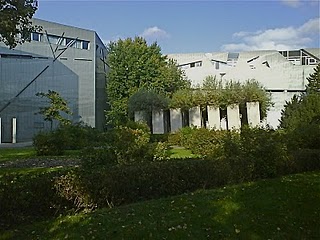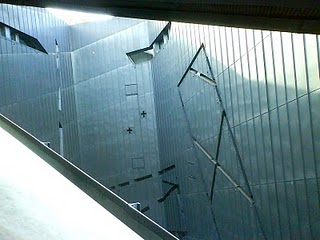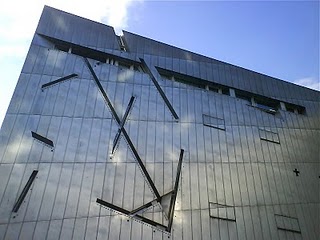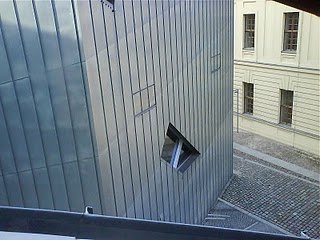The Jewish Museum
(bear with us as we try to correct some formatting problems with this page)
I first visited the Jewish Museum in 2001 when it opened. The building was empty, a vessel, the collection not yet installed; architectural tours were offered. I am still grateful to have experienced this sculpture with its insides uncluttered. The sense of disorientation was profound, one struggles to find direct ways through its discontinuous floor plan. Daniel Libeskind, the American-Polish-Jewish Architect, likens the imprint to a shattered Star of David.
Walking through the tilted space of the ‘Garden of Exile’, where olive trees encased in concrete blocks are the only elements aligned symmetrically, invites nausea. It evokes so poignantly the experience of forced emigration. The ‘Holocaust Tower’, where a blinding shard of light pierces far above, suggests both the infinite and the suffocating with its darkened edges. The exterior, meanwhile, is a knife edge, the zinc scratched with wounds, as if the incision did damage to the weapon. The building speaks of the perseverance and the trauma of a persecuted people.

In 2001, Libeskind guided the response of visitors with allusions to ETA Hoffmann, Walter Benjamin, Paul Celan and, most notably, Schoenberg’s unfinished opera Moses and Aron. His music ends with the words:
O Wort, du Wort, das mir fehlt!
Oh Word, you Word, that escapes me!
Moses is looking for an absolute perception of God, but it is beyond his understanding. It is entirely appropriate that the opera is unfinished, with only two full acts, and that no word can fill the void.
Libeskind says of his Jewish Museum ‘I sought to complete that opera architecturally.’
Wait! I need a moment to recover. I am a secular person, but I am still stunned by the claim that the building is the architectural completion of Schoeneberg’s third act, that it is Moses’ missing word.
The zinc has weathered blue over time, the museum has filled with a collection that cannot live up to the building, and many of the heavy-handed interpretative cues have been tactfully removed. Now a panel states simply: the architect says the interpretation of the building is open.
I love the way light plays on the zinc. It reflects clouds. Look closely.






Almost twice a week I drive by the museum. From the outside its architecture seems quite strange, unusual and experimental. I have the impression that it tries to communicate/provoke/intercede feelings rather than admiration for its design.
I visited the museum twice. I had mixed feelings about it. The documentaries where very interesting and informative. Other exhibits where quite sterile…
One thing is for sure. It's not what visitors expect and its worth a visit…
Efstathios
As for coverage of the Holocaust (admittedly only a part of the Museum’s mission) the same omission is made that I have found in 27 other related museums in Europe and the USA – little or no attention is paid to ways victims tried to help one another, only to ways perpetrators harmed them. This one-sided account deprives visitors of warranted reason to take heart from the ability of some victims to resist dehumanization, a model of behavior of great value in these stressful times. The Museum should right this display wrong.